Abstract
The total hydroxyproline: creatinine ratio has been determined in random samples of urine collected from 1577 normal Bristol children and from children with hypothyroidism, growth hormone deficiency, coeliac disease, and rickets.
The results in normal children had a profile similar to that of length velocity. When specific therapy was given to the children with growth failure there was a prompt increase in the total hydroxyproline: creatinine ratio, which occurred well before a growth spurt could be detected by anthropometry.
The ratio could be a useful chemical adjunct to anthropometry and radiology in the assessment of normal and abnormal growth. The prompt response of the ratio to changes in growth rate suggests that it may be particularly useful in studying physiological variation in growth over short periods of time and in close monitoring of treatment regimens for growth failure.
Random samples of urine may be used, automated methods of analysis are available, and other specialities find the investigation a useful one, so that for the paediatrician the urine total hydroxyproline: creatinine ratio has a potentially wide application.
Full text
PDF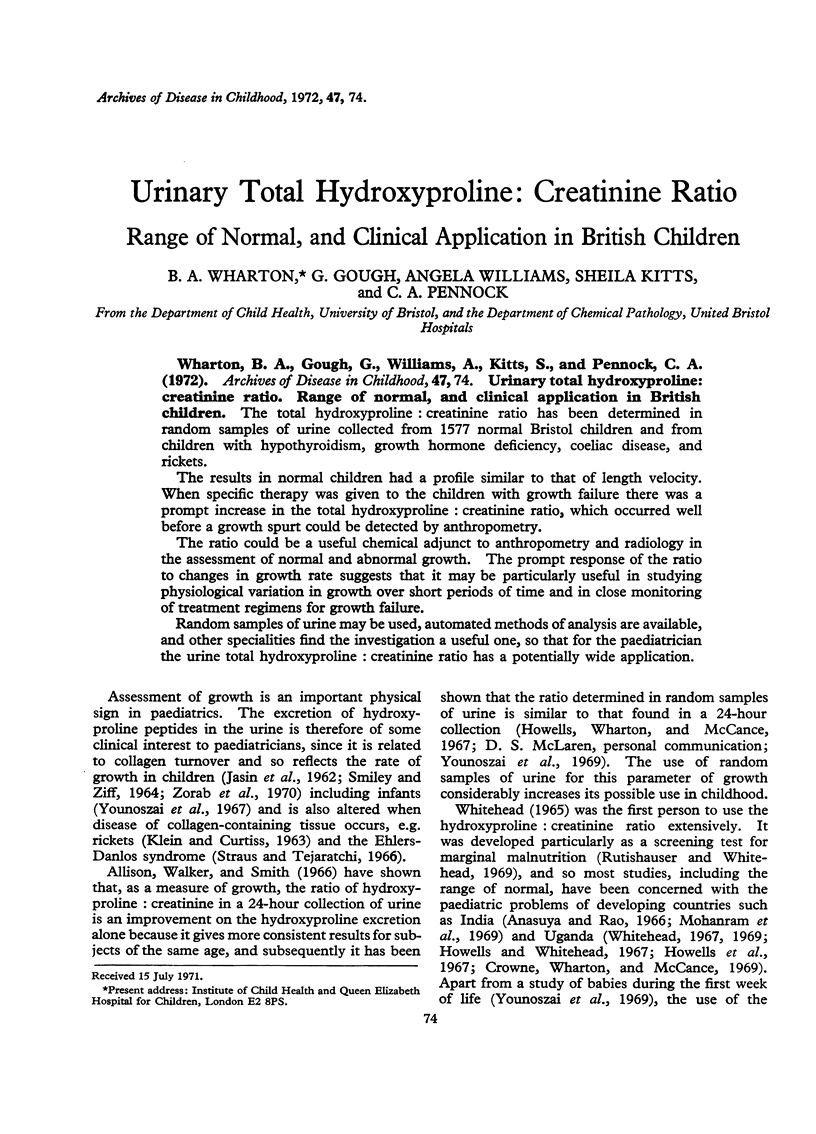
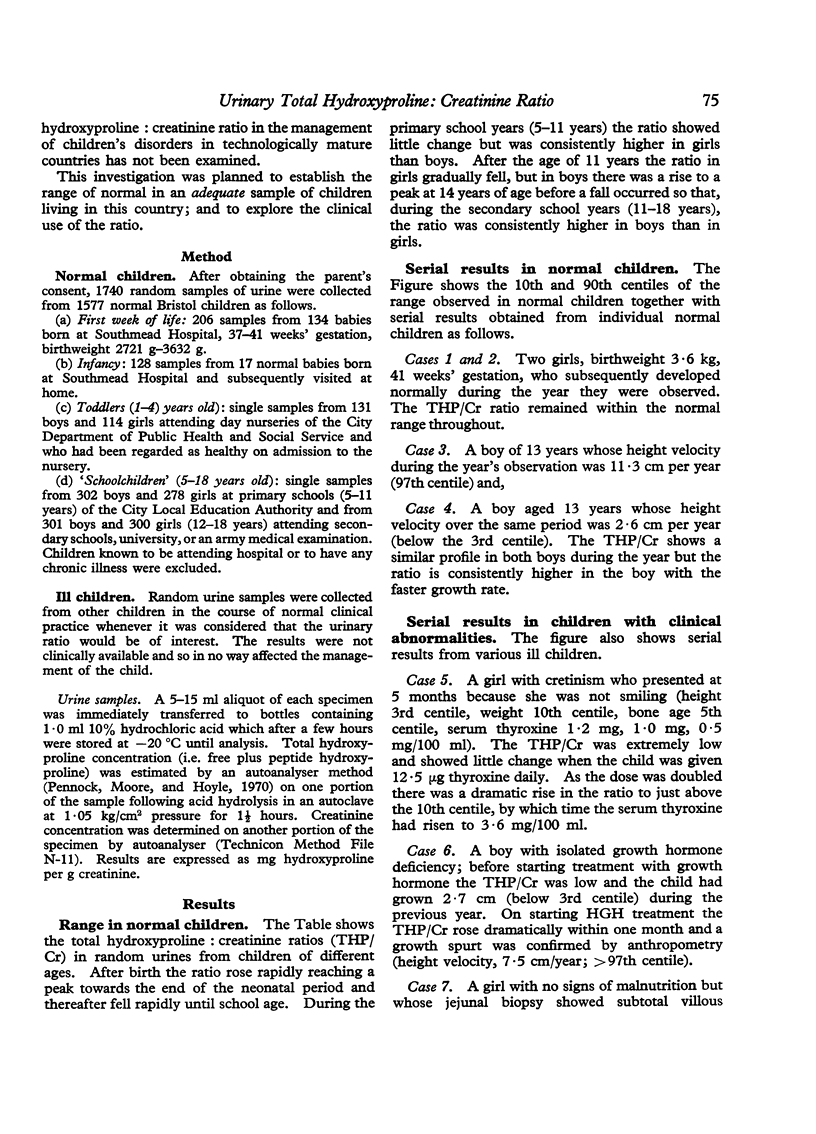
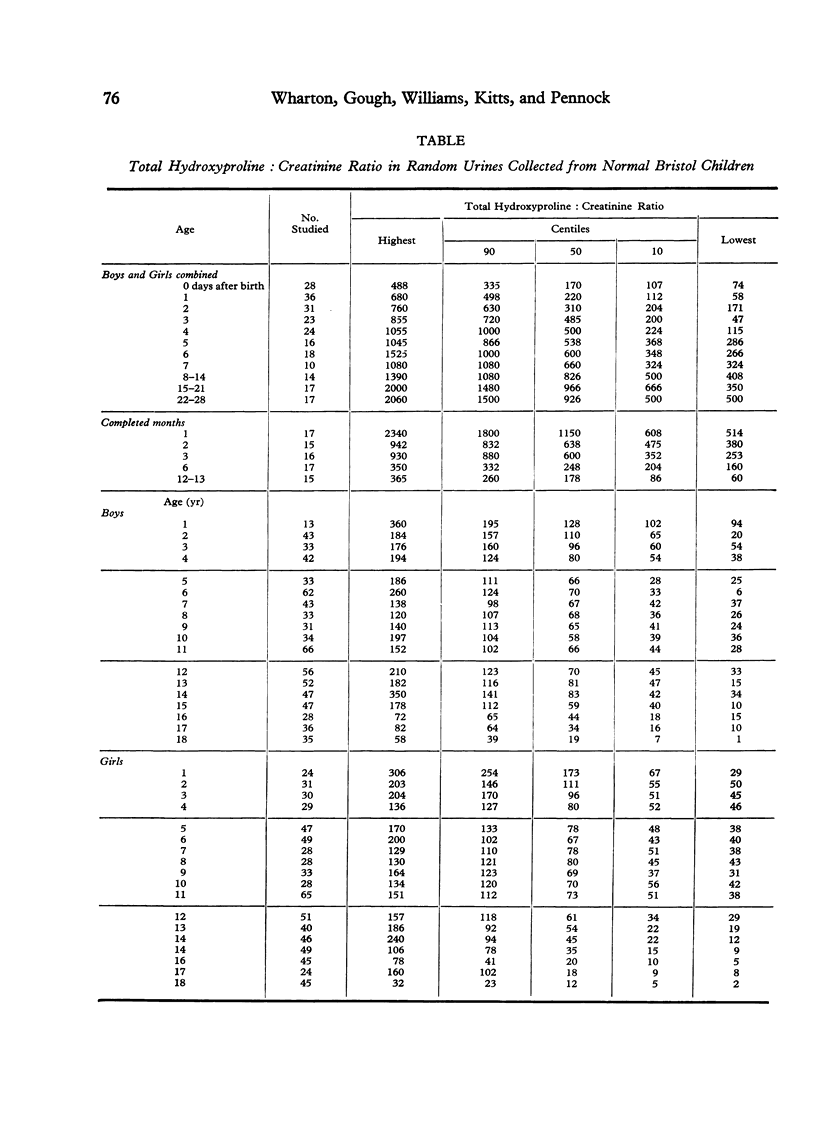
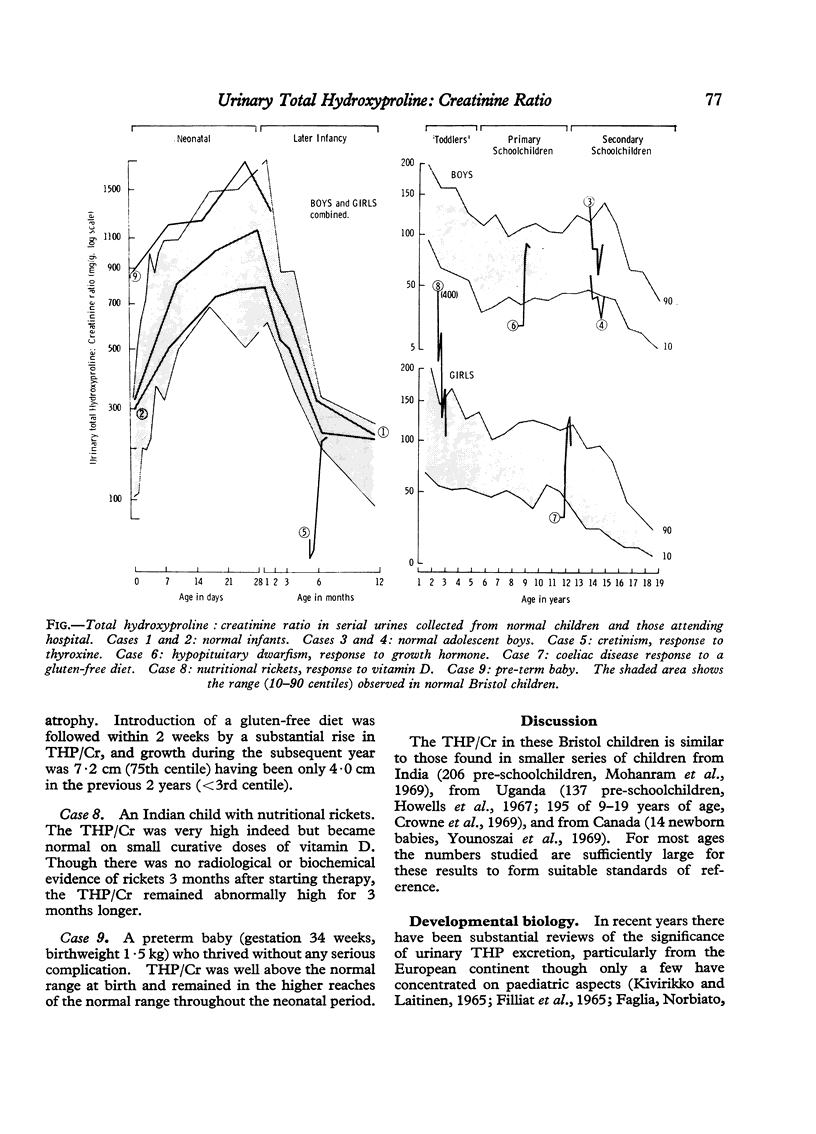
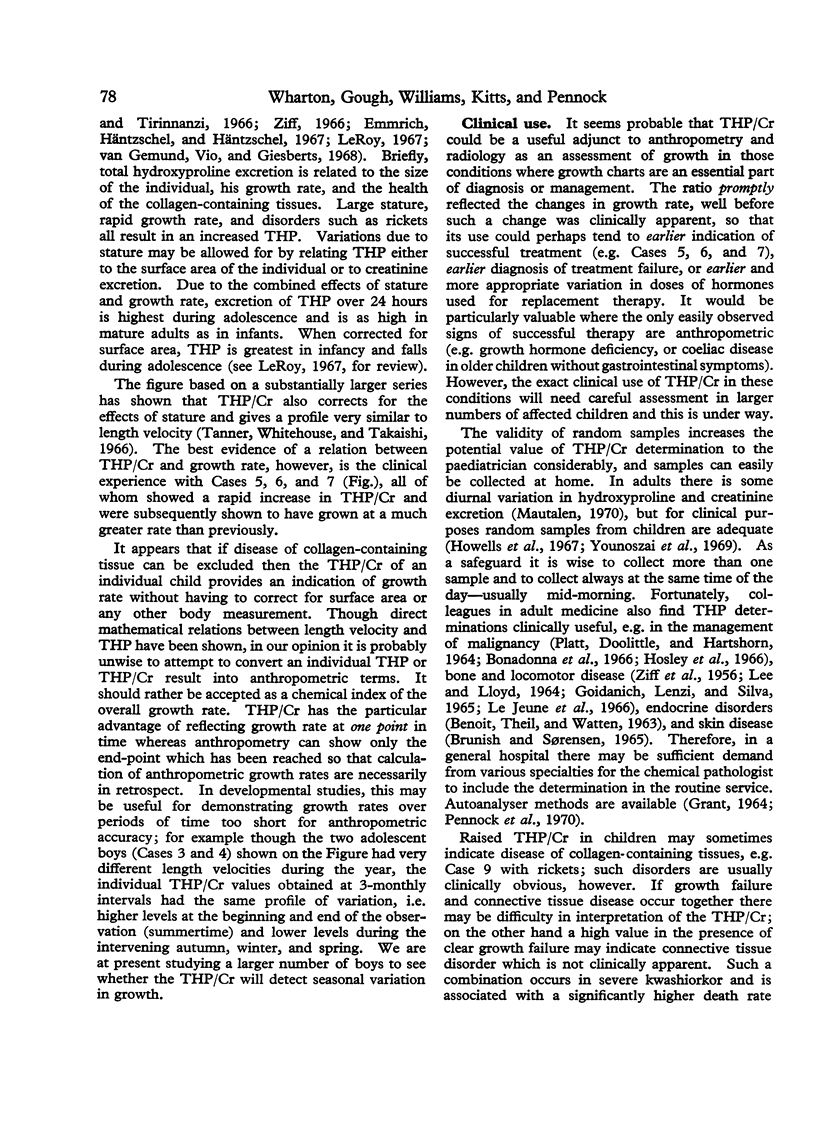
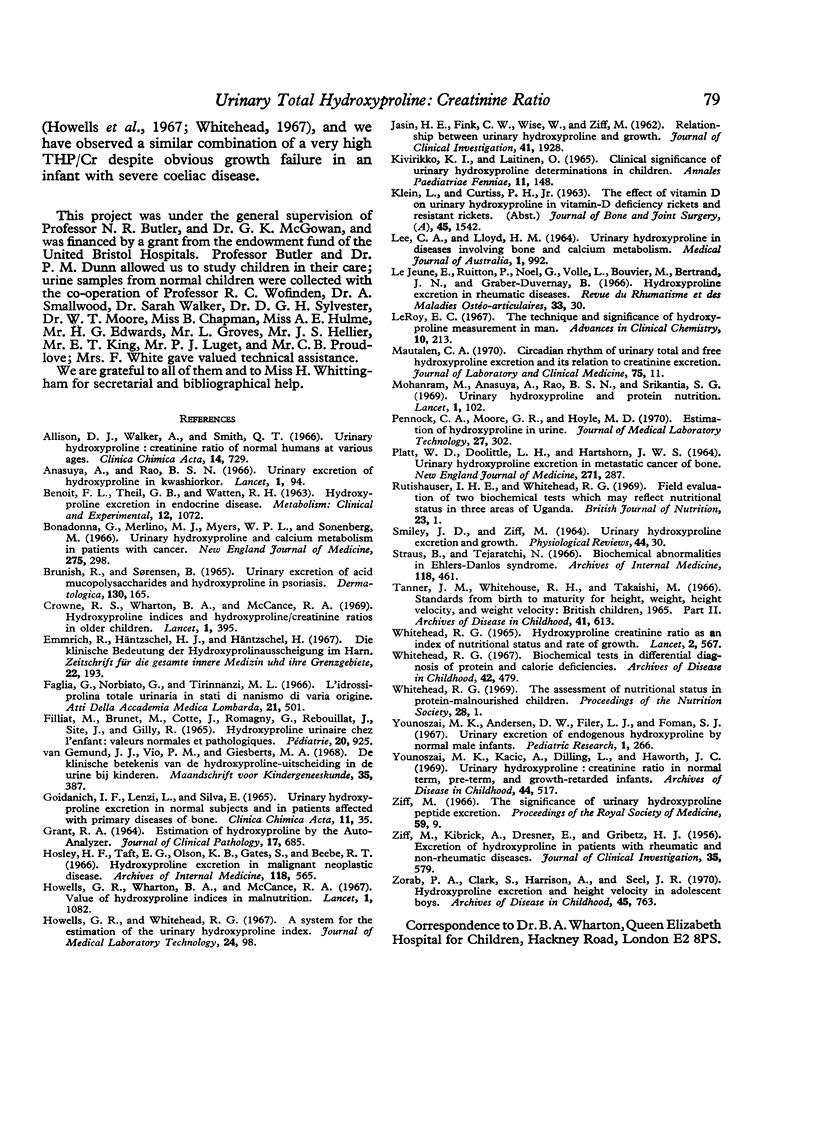
Selected References
These references are in PubMed. This may not be the complete list of references from this article.
- BENOIT F. L., THEIL G. B., WATTEN R. H. HYDROXYPROLINE EXCRETION IN ENDOCRINE DISEASE. Metabolism. 1963 Dec;12:1072–1082. [PubMed] [Google Scholar]
- Bonadonna G., Merlino M. J., Myers W. P., Sonenberg M. Urinary hydroxyproline and calcium metabolism in patients with cancer. N Engl J Med. 1966 Aug 11;275(6):298–305. doi: 10.1056/NEJM196608112750603. [DOI] [PubMed] [Google Scholar]
- Crowne R. S., Wharton B. A., McCance R. A. Hydroxyproline indices and hydroxyproline-creatinine ratios in older children. Lancet. 1969 Feb 22;1(7591):395–396. doi: 10.1016/s0140-6736(69)91358-0. [DOI] [PubMed] [Google Scholar]
- Emmrich R., Häntzschel H. J., Häntzschel H. Die klinische Bedeutung der Hydroxyprolinausscheigung im Harn. Z Gesamte Inn Med. 1967 Apr;22(7):193–199. [PubMed] [Google Scholar]
- GOIDANICH I. F., LENZI L., SILVA E. URINARY HYDROXYPROLINE EXCRETION IN NORMAL SUBJECTS AND IN PATIENTS AFFECTED WITH PRIMARY DISEASES OF BONE. Clin Chim Acta. 1965 Jan;11:35–38. doi: 10.1016/0009-8981(65)90086-0. [DOI] [PubMed] [Google Scholar]
- GRANT R. A. ESTIMATION OF HYDROXYPROLINE BY THE AUTOANALYSER. J Clin Pathol. 1964 Nov;17:685–686. doi: 10.1136/jcp.17.6.685. [DOI] [PMC free article] [PubMed] [Google Scholar]
- Hosley H. F., Taft E. G., Olson K. B., Gates S., Beebe R. T. Hydroxyproline excretion in malignant neoplastic disease. Arch Intern Med. 1966 Dec;118(6):565–571. [PubMed] [Google Scholar]
- Howells G. R., Wharton B. A., McCance R. A. Value of hydroxyproline indices in malnutrition. Lancet. 1967 May 20;1(7499):1082–1083. doi: 10.1016/s0140-6736(67)92652-9. [DOI] [PubMed] [Google Scholar]
- JASIN H. E., FINK C. W., WISE W., ZIFF M. Relationship between urinary hydroxyproline and growth. J Clin Invest. 1962 Oct;41:1928–1935. doi: 10.1172/JCI104650. [DOI] [PMC free article] [PubMed] [Google Scholar]
- Kivirikko K. I., Laitinen O. Clinical significance of urinary hydroxyproline determinations in children. Ann Paediatr Fenn. 1965;11(3):148–153. [PubMed] [Google Scholar]
- LEE C. A., LLOYD H. M. URINARY HYDROXYPROLINE IN DISEASES INVOLVING BONE AND CALCIUM METABOLISM. Med J Aust. 1964 Jun 27;1:992–995. doi: 10.5694/j.1326-5377.1964.tb127997.x. [DOI] [PubMed] [Google Scholar]
- Mautalen C. A. Circadian rhythm of urinary total and free hydroxyproline excretion and its relation to creatinine excretion. J Lab Clin Med. 1970 Jan;75(1):11–18. [PubMed] [Google Scholar]
- Mohanram M., Anasuya A., Rao B. S., Srikantia S. G. Urinary hydroxyproline and protein nutrition. Lancet. 1969 Jan 11;1(7585):102–103. doi: 10.1016/s0140-6736(69)91117-9. [DOI] [PubMed] [Google Scholar]
- PLATT W. D., DOOLITTLE L. H., HARTSHORN J. W. URINARY HYDROXYPROLINE EXCRETION IN METASTATIC CANCER OF BONE. N Engl J Med. 1964 Aug;271:287–290. doi: 10.1056/NEJM196408062710604. [DOI] [PubMed] [Google Scholar]
- Pennock C. A., Moore G. R., Hoyle M. D. Estimation of hydroxyproline in urine. J Med Lab Technol. 1970 Jul;27(3):302–307. [PubMed] [Google Scholar]
- Rutishauser I. H., Whitehead R. G. Field evaluation of two biochemical tests which may reflect nutritional status in three areas of Uganda. Br J Nutr. 1969 Mar;23(1):1–13. doi: 10.1079/bjn19690003. [DOI] [PubMed] [Google Scholar]
- SMILEY J. D., ZIFF M. URINARY HYDROXYPROLINE EXCRETION AND GROWTH. Physiol Rev. 1964 Jan;44:30–44. doi: 10.1152/physrev.1964.44.1.30. [DOI] [PubMed] [Google Scholar]
- Straus B., Tejaratchi N. Biochemical abnormalities in Ehlers-Danlos syndrome. Arch Intern Med. 1966 Nov;118(5):461–465. [PubMed] [Google Scholar]
- Tanner J. M., Whitehouse R. H., Takaishi M. Standards from birth to maturity for height, weight, height velocity, and weight velocity: British children, 1965. II. Arch Dis Child. 1966 Dec;41(220):613–635. doi: 10.1136/adc.41.220.613. [DOI] [PMC free article] [PubMed] [Google Scholar]
- Whitehead R. G. Biochemical tests in differential diagnosis of protein and calorie deficiencies. Arch Dis Child. 1967 Oct;42(225):479–484. doi: 10.1136/adc.42.225.479. [DOI] [PMC free article] [PubMed] [Google Scholar]
- Whitehead R. G. Hydroxyproline creatinine ratio as an index of nutritional status and rate of growth. Lancet. 1965 Sep 18;2(7412):567–570. doi: 10.1016/s0140-6736(65)90870-6. [DOI] [PubMed] [Google Scholar]
- Whitehead R. G. The assessment of nutritional status in protein-malnourished children. Proc Nutr Soc. 1969 Mar;28(1):1–16. doi: 10.1079/pns19690003. [DOI] [PubMed] [Google Scholar]
- Younoszai M. K., Andersen D. W., Filer L. J., Jr, Fomon S. J. Urinary excretion of endogenous hydroxyproline by normal male infants. Pediatr Res. 1967 Jul;1(4):266–270. doi: 10.1203/00006450-196707000-00003. [DOI] [PubMed] [Google Scholar]
- Younoszai M. K., Kacic A., Dilling L., Haworth J. C. Urinary hydroxyproline: creatinine ratio in normal term, pre-term, and growth-retarded infants. Arch Dis Child. 1969 Aug;44(236):517–520. doi: 10.1136/adc.44.236.517. [DOI] [PMC free article] [PubMed] [Google Scholar]
- ZIFF M., KIBRICK A., DRESNER E., GRIBETZ H. J. Excretion of hydroxyproline in patients with rheumatic and non-rheumatic diseases. J Clin Invest. 1956 Jun;35(6):579–587. doi: 10.1172/JCI103311. [DOI] [PMC free article] [PubMed] [Google Scholar]
- Ziff M. The significance of urinary hydroxyproline peptide excretion. Proc R Soc Med. 1966 Jan;59(1):9–10. [PMC free article] [PubMed] [Google Scholar]
- Zorab P. A., Clark S., Harrison A., Seel J. R. Hydroxyproline excretion and height velocity in adolescent boys. Arch Dis Child. 1970 Dec;45(244):763–765. doi: 10.1136/adc.45.244.763. [DOI] [PMC free article] [PubMed] [Google Scholar]
- van Gemund J. J., Vio P. M., Giesberts M. A. De klinische betekenis van de hydroxyproline-uitscheiding in de urine bij kinderen. Maandschr Kindergeneeskd. 1968 Jan-Feb;35(12):387–400. [PubMed] [Google Scholar]


